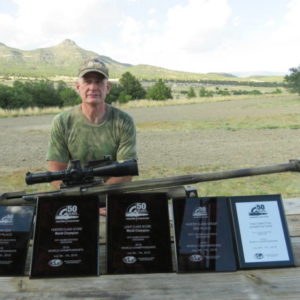 The 4th of July holiday proved to be a great weekend for one of our instructors Walter Wilkinson. The Fifty Caliber Shooters Association (FCSA) World Championships (50 BMG) were held at the NRA Whittington center in Raton, NM 5-7 July. There were shooters from Australia, Great Britain, Spain and the US in attendance. The FCSA 1000 yard matches have four classes; Light Gun, Heavy Gun, Unlimited and Hunter. In the first 3 classes, the rifles are normally shot from a machine rest off the bench. Hunter class requires the shooter to fire from the ground with a bipod.
The 4th of July holiday proved to be a great weekend for one of our instructors Walter Wilkinson. The Fifty Caliber Shooters Association (FCSA) World Championships (50 BMG) were held at the NRA Whittington center in Raton, NM 5-7 July. There were shooters from Australia, Great Britain, Spain and the US in attendance. The FCSA 1000 yard matches have four classes; Light Gun, Heavy Gun, Unlimited and Hunter. In the first 3 classes, the rifles are normally shot from a machine rest off the bench. Hunter class requires the shooter to fire from the ground with a bipod.
The match is broken down into 2 relays for each shooter, each relay having 3 strings of fire across two days. The shooter fires 5 rounds for score in each string, for a total of 30 rounds with a possible score of 300. In addition to score, the group size is also measured, thus creating two matches, one for score and one for group. Each day, the shooter fires in a different relay to level the competition, as normally the wind conditions are best in the morning (relay 1 and 2) and worse later in the day (relays 3 and 4). So if a shooter fires in relay 1 on the first day, they will fire in relay 3 on the second. Most shooter compete in two classes of fire.
Day one had Walt firing in relays 3 and 4, competing in Light Gun and Hunter class. He shoots both of these classes with a stock, off-the-shelf Steyr HS-50 from the ground. The winds were coming in from behind the shooters, switching from 4 to 8 o’clock and changing speeds from nothing to 13mph. “These conditions are very hard to shoot in. If you take your eyes off the ball, the wind can change direction from the time you close the bolt to when you fire. And when you are holding 24 inches right for a 4 o’clock wind and it switches either speed or direction, your shot changes from a nice 10 ring (12″ circle) hit to one out in the 5 ring.” The scores on day 1 for relays 3 and 4 reflected the bad wind conditions and put many shooters out of the running completely. Walt dropped 5 points in Light Gun and 5 points in Hunter, shooting a 145-4X and 145-5X respectively placing him 2nd in Light Gun and 1st in Hunter. “I couldn’t do anything wrong. It was like every time the wind changed I know exactly where to hold and the bullets just kept going where I wanted them to. The highlight of the day was the last two strings of fire in Hunter during relay 4. I shot a 50-2X with a 9 3/4″ group and a 49-2X with a 7 15/16″ group. The 10 ring is right at 1.15 MOA and when you keep them all in that it says something about your rifle and your load. During both of those two strings, I changed from holding on the right side of the target to the left side during the string. That was very satisfying.”
On the second day Walt was shooting in the morning on relays 1 and 2. Conditions were better but still very tricky. “When there is less wind on the 1000 yard range, the thermals off the 200 through 900 yard berms create havoc with your vertical. Then the wind will start and you have to instantly make adjustments to both elevation and windage. That is one advantage I have going against the machine rest guys. I decide on my hold just seconds if not right as I shoot, where they have to move the rest around to get where they need to be.” The vertical from the thermals showed up in Walt’s groups, but he still kept them in the center finishing the day with a 146-3X and a 145-5X.
In the end, Walt finished 1st in both Light Gun Score (291-5X) and Hunter Score (290-10X), winning the world championship in both those classes. Both of his scores were higher than any other class in the match. He finished 3rd in Hunter Group and was on the winning 4 shooter team. His score landed him in 4th place overall in the Two-Gun category. “That was pretty nice. Shooting from the ground with a stock rifle against the bench guys and taking 4th was pretty sweet. I have won the Hunter Class World Championship 2 times before, but this is my first Light Gun win and the only reason I did was the horrible wind conditions. I guess all my time out there on 50 Cal Ridge (Gunsite) practicing has paid off.”
Walter Wilkinson has been an instructor at Gunsite since 2007 and primarily works in the advanced skills classes. He designed and built most of the ranges used in the precision rifle classes. “I like the fact that 50% of our training in the long range rifle classes is about learning to accurately read and adjust for the wind. Because at long range it is what decides weather you hit or not. You have to make the wind your friend, otherwise, it is a very formidable enemy.


